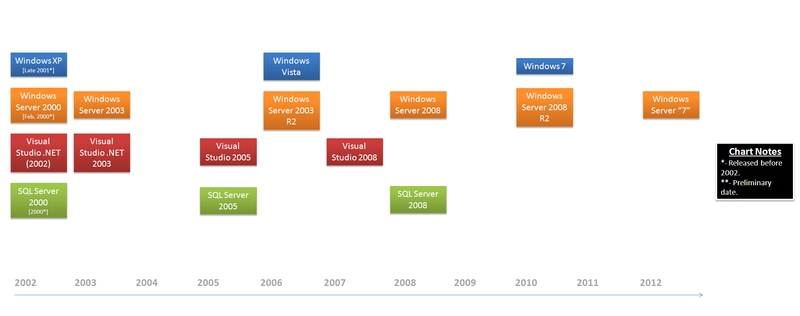Windows Server versioonid: Difference between revisions
No edit summary |
|||
| Line 27: | Line 27: | ||
== ''' Windows NT Advanced Server ''' == | == ''' Windows NT Advanced Server ''' == | ||
Windows NT arendus algas aastal 1988 pärast seda, kui Microsoft palkas grupi arendajaid Digital Equipment Corporation'ist, keda juhtis Dave Cutler. | |||
'''Süsteemi tugi''' | |||
NT disainiti algusest peale olema üleviidav teistele platvormidele. Kõik kernel kernel'i ja allsüsteemide koodid kirjutati C ja C++ programmeerimiskeeles. Kõik muudatused põhi riistvara arhitektuuris, mida ei saanud lahendada lihtsa uuestikompileerimise teel (nt. mälu arhidektuur, multi/üksikprotsessori tugi) olid jäetud [http://en.wikipedia.org/wiki/Hardware_abstraction_layer HAL'i] kaela. | |||
Also, NT's boot architecture borrowed heavily from the ARC initiative, particularly on non-x86 platforms. | |||
i860 | |||
Originally, NT was targeted at the Intel i860 CPU, codenamed N10 (or "N-Ten"). However, the i860 was "horribly behind schedule", so the NT team used an emulator before i860 prototype systems designed in-house (code-named Dazzle) were available. Support for the other platforms followed later and no public release of NT for i860 systems was made. The rationale for targeting the i860 first was to improve portability and avoid producing an x86-centric design.[4] | |||
[edit]x86 | |||
NT 3.1 supported the Intel x86 32-bit family (80386 and later). Compared to 16-bit Windows 3.x, NT's driver support was somewhat limited. Windows NT 3.1 is the only version of Windows NT that supports multiprocessor 386-based machines.[5] | |||
[edit]MIPS | |||
Windows NT also supported the MIPS R4000 processor; specifically MIPS systems following the Advanced RISC Computing (ARC) specification. | |||
[edit]Alpha | |||
Early in the NT beta cycle, support was added for the DEC Alpha processor. However, because the Alpha itself was not released, Microsoft's developers did not have access to production Alpha machines to develop on until shortly before NT shipped. Consequently, NT did not initially ship with Alpha support out of the box: the first packages of NT included a mail-in coupon to receive a free CD of NT 3.1 with Alpha support. | |||
== ''' Windows NT 3.5 Server ''' == | == ''' Windows NT 3.5 Server ''' == | ||
Revision as of 13:53, 28 November 2010
Sissejuhatus
Windows Server'i versioone antakse välja iga 4 aasta järel, aga välja andmise skeemi iseloomustab kõige paremine alljärgnev muster: Iga 2 aasta järel lastakse välja versioon, mis baseerub eelmisele versioonile ja peamiselt parandab eelmise versiooni vigu ja uuendab teenuseid, mis olid eelmisel süsteemil. Näitena võib tuua Windows Server 2003 R2. Ja iga 4 aasta järel lastakse välja versioon, mille tarkvara võib erineda eelmise versiooni omast nii palju, et ei pruugi sellega töödata. Näiteks Windows Server 2008.
Windowsi Serveri (joonisel Oranžiga) versioonide välja andmist iseloomustab alljärgnev graafik:

Serverid
Windows NT Advanced Server - välja antud 27. juulil 1993.
Windows NT 3.5 Server - välja antud 21. septembril 1994.
Windows NT Server - välja antud 30. mail 1995.
Windows 2000 Server - välja antud 17. veebruaril 2000.
Windows Server 2003 - välja antud 24. aprillil 2003 (R2 anti välja 6 December 2005).
Windows Server 2008 - välja antud 4. veebruaril 2008.
Windows Home Server - välja antud 7. jaanuaril 2007.
Windows Server 2008 R2 - välja antud 22. juuli 2009 (startis 22. oktoobril 2009).
Windows NT Advanced Server
Windows NT arendus algas aastal 1988 pärast seda, kui Microsoft palkas grupi arendajaid Digital Equipment Corporation'ist, keda juhtis Dave Cutler.
Süsteemi tugi
NT disainiti algusest peale olema üleviidav teistele platvormidele. Kõik kernel kernel'i ja allsüsteemide koodid kirjutati C ja C++ programmeerimiskeeles. Kõik muudatused põhi riistvara arhitektuuris, mida ei saanud lahendada lihtsa uuestikompileerimise teel (nt. mälu arhidektuur, multi/üksikprotsessori tugi) olid jäetud HAL'i kaela. Also, NT's boot architecture borrowed heavily from the ARC initiative, particularly on non-x86 platforms.
i860
Originally, NT was targeted at the Intel i860 CPU, codenamed N10 (or "N-Ten"). However, the i860 was "horribly behind schedule", so the NT team used an emulator before i860 prototype systems designed in-house (code-named Dazzle) were available. Support for the other platforms followed later and no public release of NT for i860 systems was made. The rationale for targeting the i860 first was to improve portability and avoid producing an x86-centric design.[4] [edit]x86 NT 3.1 supported the Intel x86 32-bit family (80386 and later). Compared to 16-bit Windows 3.x, NT's driver support was somewhat limited. Windows NT 3.1 is the only version of Windows NT that supports multiprocessor 386-based machines.[5] [edit]MIPS Windows NT also supported the MIPS R4000 processor; specifically MIPS systems following the Advanced RISC Computing (ARC) specification. [edit]Alpha Early in the NT beta cycle, support was added for the DEC Alpha processor. However, because the Alpha itself was not released, Microsoft's developers did not have access to production Alpha machines to develop on until shortly before NT shipped. Consequently, NT did not initially ship with Alpha support out of the box: the first packages of NT included a mail-in coupon to receive a free CD of NT 3.1 with Alpha support.
Windows NT 3.5 Server
Windows NT Server
Windows 2000 Server
Windows Server 2003
Windows Server 2008
Windows Home Server
Windows Server 2008 R2
Autor
Urmo Laaneots A21